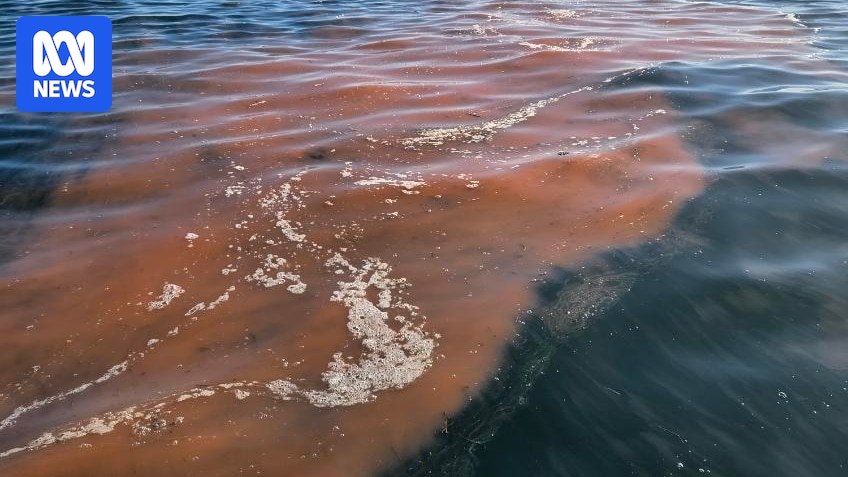An ecologist says an “algal war” that has broken out along South Australia’s south coast could be a sign that the tide is slowly turning against the state’s toxic bloom, which the Greens want treated as a national disaster.
Fishers have reported seeing what is believed to be a bioluminescent algae that is known to eat the Karenia mikimotoi algae species responsible for the mass fish kills over the past four months.
The Greens have called on the federal government to declare the bloom a national disaster because of its impact on coastal communities and businesses.
“The last calamari I caught was on Good Friday … and it’s been a long time since,” Fleurieu Peninsula squid fisherman Nathan Eatts told ABC Radio Adelaide.
Mr Eatts collected samples from the water for further analysis. (Supplied: Nathan Eatts)
But Mr Eatts is hopeful nature itself can be part of the solution, especially in light of what he saw while fishing on Sunday morning.
He said he was out on the water when he noticed it had changed colour.
“It just went bright red, the water,”
he said.
“I followed it around for a bit. It was about a kilometre-and-a-half long by 30 metres wide.
“Early reports coming back off that, is that it’s a ‘sea sparkle’ — a bioluminescent algae of sorts.
“Apparently that might potentially be eating the Karenia, the bad stuff.”
Mr Eatts said he contacted authorities and carefully collected samples for citizen scientists.
‘Sparkle’ of hope
Estuarine ecologist Faith Coleman said she had examined images of the samples and identified them as containing Noctiluca scintillans — the algae which causes “sea sparkle”.
“We’re starting to get sea sparkle blooms which are those algae that cause the phosphorescent blue waves at certain times of year,” she said.
“What they do is they go round, they eat other bacteria and algae, and in this case it looks like they’re probably eating Karenia mikimotoi.
Ecologist Faith Coleman has taken a keen interest in the algal bloom. (ABC News: Che Chorley)
“The sea sparkle … cleans up already dying blooms and it cleans them down to a point that they don’t re-bloom again if they get the opportunity to.
“We’re nowhere near that yet.”
While Ms Coleman said it was “definitely way too early to say” the sea sparkle would spell the end of the toxic bloom, it was still a promising sign.
“It’s an algal war zone,”
she said.
“Nature is assembling her soldiers on the ground and the sea sparkle is a major part of that.
“That’s what it’s trying to do — whether it succeeds of course is a different matter entirely.”
Calls for national response
South Australian Greens Senator Sarah Hanson-Young says the party, at both the state and federal level, is calling for inquiries into the ‘environmental catastrophe’.
Senator Hanson-Young said she had written to Prime Minister Anthony Albanese seeking an urgent national response.
“We’ve urged the prime minister to declare this event a national disaster along the lines of what happens for floods and fires,” Senator Hanson-Young said.
Dead Port Jackson shark among marine life washed up on Aldinga Beach last month. (ABC News: Olivia Mason)
“Our communities are hurting, our industries are suffering and so far, the only government response is to get used to it.”
“If these dead fish were washing up on the shores of Bondi Beach on the North Shore of Sydney, it would be a national outcry.”
Greens MLC Robert Simms said he would move to launch a state-based enquiry into the bloom when parliament returns in late August.
“That’s so that we can bring in the state government departments and scrutinise their approach to this crisis,” Mr Simms said.
The prime minister’s office has been contacted for a response.
An underwater Chernobyl
Diver Mark Tozer has been visiting the shipwreck of The Claris, a popular scuba site around eight kilometres off Glenelg Beach, for the past 30 years.
He said the site was normally teeming with marine life and coral and was devastated when he visited the site last week.
Diver Mark Tozer described the devastation as an underwater ‘Chernobyl’ when he visited the dive spot last week.
“My immediate thought when I was diving was Chernobyl, this is just absolute devastation,”
Mr Tozer said.
“On the way down it was green and was full of algae just floating through the water column and by the time you got to the bottom you could hardly see your hand, it was nasty,” he said.
“Littered all over the floor were dead sea cucumbers, there was clams and molluscs just open, dead, gone … it was a death zone.”
Mr Tozer said the reef off Glenelg Beach was teeming with fish when he visited in July last year. (Supplied: Mark Tozer)
Mr Tozer said he was surprised to see the far-reaching extent of the bloom and felt concern for the future of the diving industry and local bait and tackle shops.
“The government needs to step in and understand these poor people who own a business … this is out of their hands,” he said.
“Who would want to buy a boat in South Australia now?”
